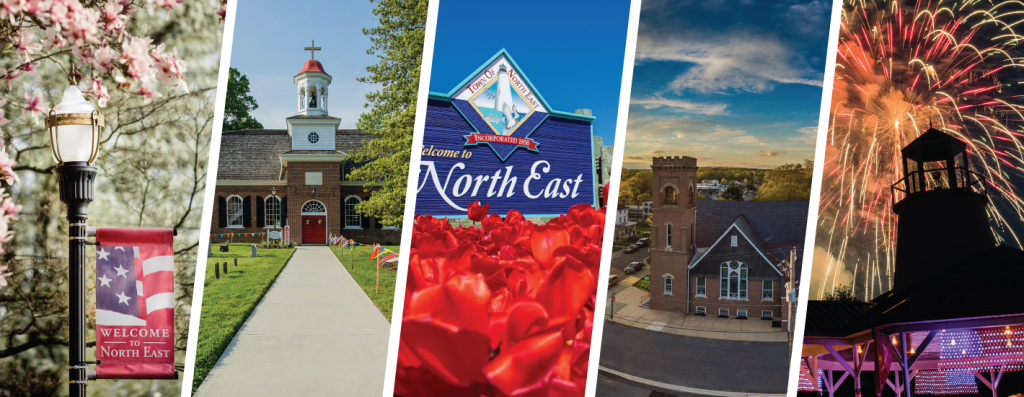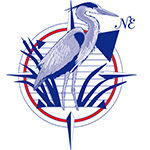
North East is nested at the head of the Chesapeake Bay. Located only 50 miles from Baltimore or Philadelphia, via Interstate 95, it’s easily accessible and ready for commercial and residential growth. With a resident population of nearly 4,000 people, the town is host to thousands of visitors during the summer months.
Settled prior to 1700 and incorporated in 1850, North East offers warmth and charm to those who visit its many attractions.
 Main Street in North East is in the process of a renaissance – offering several attractive antique shops with treasures from the past, crafts and collectible shops, as well as restaurants for casual dining.
Main Street in North East is in the process of a renaissance – offering several attractive antique shops with treasures from the past, crafts and collectible shops, as well as restaurants for casual dining.
North East is also experiencing industrial growth. The North East Commerce Center, located directly off I-95, houses the regional headquarters for Delmarva Power and the Flying “J” Travel Plaza. A short distance past the Commerce Center is the main campus for Cecil College.
Many excellent tourist attractions exist within the town limits including St. Mary Anne’s Episcopal Church, dating back to the 1700’s. The graveyard surrounding the church is one of the oldest in Maryland and contains graves of Susquehannock Indians dating back to the 1600’s.
Elk Neck State Park, a major recreational area, is located just 10 miles south of town. It is one of many recreational opportunities in the area.
 North East is proud to be the home to the Upper Bay Museum which preserves the heritage of the commercial and recreational hunter. Located in the beautiful North East Community Park on the banks of the North East River, the museum offers one of the largest collections of hunting and fishing memorabilia in this area. The park includes picnic pavilions, volleyball courts numerous benches, and a paved walkway with plenty of parking.
North East is proud to be the home to the Upper Bay Museum which preserves the heritage of the commercial and recreational hunter. Located in the beautiful North East Community Park on the banks of the North East River, the museum offers one of the largest collections of hunting and fishing memorabilia in this area. The park includes picnic pavilions, volleyball courts numerous benches, and a paved walkway with plenty of parking.
With several large housing developments, increased commercial growth and surrounding marinas, North East is a town looking towards the future while preserving it’s historical small town charm. North East is a town with “Something for Everyone”.
If you are considering visiting or relocating to North East, please take advantage of the many resources within our website, or contact us for more information.
The History of North East, Maryland
Captain John Smith’s expedition found its way to the Northeast River in 1608.The North East area provided Indians with abundant hunting grounds and a fishery rich in stock.
Amid numerous skirmishes and treaties with the Indian tribes, European settlers moved south from Delaware and Pennsylvania to the area. Likewise, settlers arrived by water from Virginia and other parts of Maryland. In 1711 there was a mill where the Big and Little North East creeks came together. In 1716 there was another mill at the falls of the North East. In 1739 George Whitefield preached from his diary, to about 1,500 people at North East.
Throughout the early history of North East, the Northeast River has played a significant role. The ruins of an early mill stand today near the Mill House. The frame building of the Mill House, circa 1710, represents an outstanding example of early vernacular architecture.
Because of the availability of water for power, British businessmen established an iron works near North East, called the Principio Company, in 1735. It later became known as the North East Forge. George Washington’s father and brother maintained an interest in the Principio Company. After confiscation from the British in 1780. Thomas Russell and his son operated the forge until it was leased to James and George Whitaker in 1829. After the Whitakers sold the forge in 1837, several other owners operated the forge until 1847 when Jethro McCullough, Delaphine McDaniel and Edward Harvy purchased it. The McCullough and Iron Company, formed in 1861, produced the first galvanized sheet iron in the United States.
In 1706, the General Assembly of Maryland passed and an act establishing the North Elk Parish. After fire destroyed the original church, the current structure was constructed in 1742-43. The granite cornerstone of the church bears the initials of the 1742 rector and his vestry.
Before Queen Anne of England died in 1714, she set aside and allocated funds for missionary work overseas. From Queen Anne’s bounty, St. Mary’s received a silver chalice and paten made in London, 1716-1717; a large Bible printed in Oxford, England in 1716 and a large Book of Common Prayer. It is believed that in appreciation for these gifts, the name was changed to St. Mary Anne’s Church.
Although times have changed, the small town continues to offer the beauty of the water that attracted its original settlers and the charm of small town life. We invite you to share in the history of our town, which we cherish. We believe that you too will discover the symbol of the Great Blue Heron, meaning that you have found the Land of Pleasant Living.
